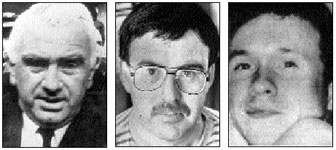1 February 2007 Edition
Remembering the Past

Paddy Loughran, Pat McBride and Michael O’Dwyer
1992: Ten nationalists killed in one week
BY ARAN FOLEY
Fifteen years ago this week, on 4 February 1992, a member of the RUC’s elite Divisional Mobile Support Unit launched a gun attack on people inside Sinn Féin’s advice centre in Belfast’s Lower Falls. Three were killed and another two seriously wounded.
The three who died were 61-year-old office attendant Paddy Loughran; Sinn Féin activist Pat McBride; and a member of the public who had come to the centre seeking advice, Michael O’Dwyer (25). The two injured were 28-year-old Sinn Féin activist Pat Wilson and another member of the public, Norah Larkin.
It was the first mass killing in a week which was to see ten nationalists murdered.
Two Catholics had already been gunned down by loyalist death squads. On 30 January, Lisburn man Paul Moran (32) was shot dead while he was buying a newspaper in a local shop. And on 2 February, Belfast taxi driver Pádraig Ó Cléirigh (52) was gunned down in his home in Rosemount Gardens, Belfast. He had been a prominent member of Conradh na Gaeilge.
The carnage at the Sinn Féin office began shortly after 1.15pm when RUC Constable Alan Moore gained access to the office by posing as a journalist. Sinn Féin worker Paddy Loughran contacted the press office located above the centre and almost simultaneously was heard to shout over the intercom: “He’s got a gun!” Shots rang out from a pump-action shotgun and confusion reigned.
Witnesses reported one and possibly two men fleeing the scene in a blue BMW.
At 1.30pm, the RUC arrived and immediately began assaulting those trying to enter the building to give aid to the wounded, at one point smashing a rifle butt into the stomach of a pregnant woman.
Within hours, the RUC was releasing its version of events about an officer who had “gone off the rails” due to the pressure of the job – a story eagerly consumed by the mainstream media, North and South. After the murders, Moore was reported to have driven about 15 miles to the shores of Lough Neagh and turned his gun on himself.
At a press conference the following day, on 5 February, Sinn Féin President Gerry Adams dismissed the rogue cop story out of hand. He said that the state’s and media’s demonisation of Sinn Féin had made this sort of attack inevitable. He went on to reject the notion that an RUC man’s stressful lifestyle in any way justified the murder of party members or members of the public.
In relation to whether the attack involved one or two individuals, Gerry Adams said that this could be cleared up by the release of CCTV footage from the British Army observation tower in Divis Flats, which had the advice centre and surrounding area under constant surveillance. The British Army refused to release the film.
SEÁN GRAHAM’S BOOKIES
Less than 20 minutes after the press conference had ended, two masked and heavily-armed men entered Seán Graham’s bookmaker’s shop and opened up with assault rifles on the packed shop, killing five and wounding nine. The dead were all from the Lower Ormeau Road and Markets area. They were pensioner Jack Duffin (66); Chris Doherty, in his 40s; Willie McManus, in his 50s; Peter McGee (19) and James Kennedy, aged just 15.
Despite the fact that the shooting went on for at least five minutes the gunmen – members of the UDA/UFF – calmly walked across the Ormeau Road into University Street and got into a car where RUC Land Rovers had been parked only minutes before, raising the spectre of collusion.
Ironically, the man responsible for the importation from apartheid South Africa of the weapons used in the Seán Graham’s massacre, Brian Nelson – the UDA’s most senior intelligence officer who was a British Army Military Intelligence agent at the same time – was sentenced to ten years’ imprisonment on 3 February 1992.
Brian Nelson had received the sentence as part of a deal which saw murder charges dropped by the state to ensure his silence on state collusion by the RUC and British Army with the loyalist death squads of the UDA and UVF. The more serious charges of murder had been dropped and the ten-year sentence meant he would spend less than five years in prison. Along with the importation of the weapons, the British Army agent had been involved in dozens of murders, including that of prominent human rights solicitor Pat Finucane in Belfast in 1989.
 • Seán Graham’s bookmaker’s shop, Lower Ormeau Road
• Seán Graham’s bookmaker’s shop, Lower Ormeau Road


